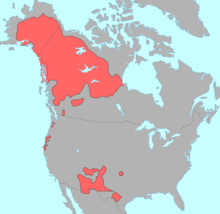Tlingit (language)
| Tlingit (Lingít Yoo X̲'atángi) | ||
|---|---|---|
|
Spoken in |
Southeast Alaska , Western Canada | |
| speaker | 800 | |
| Linguistic classification |
|
|
| Official status | ||
| Official language in | not applicable | |
| Language codes | ||
| ISO 639 -1 |
- |
|
| ISO 639 -2 |
tli |
|
| ISO 639-3 | ||
Tlingit or Lingít is the language of the Tlingit people from Southeast Alaska and Western Canada . It is generally included in the Na-Dené language group and is therefore related to the Athapaskan languages. Tlingit is spoken by around 800 native speakers (mostly older speakers), so it is critically endangered. In southern Alaska one tries to revive and preserve the language and culture with special programs.
classification
Many researchers group Tlingit together with the Eyak and the Athapaskan languages to form the so-called Na-Dené languages . However, the specialists Krauss and Golla (1981) formulate rather cautiously:
"Tlingit bears a close resemblance to Athabaskan-Eyak in phonology and grammatical structure, but shows little regular correspondence in vocabulary ... and therefore the nature of the relationship between Athabascan-Eyak and Tlingit remains an open question."
Since the Haida is generally no longer counted as part of the Na-Dené today, the following classification results, although it cannot be completely ruled out that the Tlingit is an isolated language .
-
Na Dené languages
- Tlingit
- Eyak-Athapaskan
For the position of the tlingit in the hypothetical Dene-Caucasian see the article on this macro family .
history
Very little is known about the history of Tlingit, especially since there are no written records prior to first contact with Europeans around 1790 and they are sparse and irregular afterwards until the early 20th century. The language seems to have spread northward from the Ketchikan - Saxman area to the Chilkat region, as some conservative features have been gradually reduced to the north.
Dialects
Tlingit is divided into four main dialects, which are essentially mutually understandable. The northern dialect is mainly spoken in the region south of Lituya Bay to Frederick Sound . The southern dialect is spoken from the south of Frederick Sound to the border between Alaska and Canada , with the exception of Annette Island , the reservation of the Tsimshian , and the southern end of the Prince of Wales Island , the land of the Kaigani Haida . Another dialect, the Inland Tlingit , is found in Canada around Atlin Lake and Teslin Lake . Another can be found in the Saxman area near Ketchikan, known as Tongass ( Taanta K̲wáan ) Tlingit . Presumably this is a relic of an intermediate language between Tlingit and Tsimshian.
literature
- ↑ quoted in Campbell 1997, p. 114, see Google Books
- Franz Boas : Grammatical notes on the language of the Tlingit Indians . University of Pennsylvania Museum anthropological publications, 1917.
- Nora M. Dauenhauer, Richard Dauenhauer (eds.): Haa shuká [Our ancestors] . University of Washington & Sealaska Heritage Foundation, Seattle 1987.
- Nora M. Dauenhauer, Richard Dauenhauer: Haa Tuwunáagu Yís [For healing our spirit] . University of Washington & Sealaska Heritage Foundation, Seattle 1990.
- Nora M. Dauenhauer, Richard Dauenhauer (Eds.): Haa K̲usteey / i, our culture: Tlingit life stories . Classics of Tlingit oral literature (No. 3). University of Washington & Sealaska Heritage Foundation, Seattle 1994.
- Nora M. Dauenhauer, Richard Dauenhauer (Eds.): A Tlingit ceremonial speech by Willie Marks . In: M. Dürr, E. Renner, W. Oleschinski (Eds.): Language and culture in Native North America , LINCOM, Munich 1995, pp. 239-244.
- Nora Marks Dauenhauer, Richard Dauenhauer: Beginning Tlingit . 4th ed. Sealaska Heritage Foundation Press: Juneau AK 2000, ISBN 0-9679311-1-8 (First edition 1994).
- Nora Marks Dauenhauer, Richard Dauenhauer: Lingít X̲'éinax̲ Sá! Say it in Tlingit: A Tlingit phrase book . Sealaska Heritage Institute, Juneau AK 2002, ISBN 0-9679311-1-8 .
- Richard Dauenhauer: Text and context of Tlingit oral tradition . Doctoral dissertation, University of Wisconsin, Madison 1974.
- Mattew Dryer: Tlingit: An object-initial language? In: Canadian Journal of Linguistics , 30, 1985, pp. 1-13.
- Michael Dürr, Egon Renner, Wolfgang Oleschinski (Eds.): Language and culture in Native North America: Studies in honor of Heinz-Jürgen Pinnow . LINCOM studies in Native American linguistics (No. 2). LINCOM, Munich 1995, ISBN 3-89586-004-2 .
- Jeffery A. Leer: Tlingit A portmanteau language family? In P. Baldi (ed.): Linguistics change and reconstruction methodology Mouton de Gruyter, Berlin 1990, pp. 73-98.
- Jeffery A. Leer: The Schetic Categories of the Tlingit verb . PhD dissertation. University of Chicago Department of Linguistics, Chicago IL 1991.
- Constance M. Naish: A syntactic study of Tlingit . Unpublished MA thesis. University of North Dakota, 1966.
- Constance M. Naish, Gillian L. Story: Tlingit verb dictionary . Summer Institute of Linguistics, College AK 1973.
- Constance M. Naish, Gillian L. Story: The English-Tlingit dictionary: Nouns . (3rd ed .; H. Davis & J. Leer, Eds.). Sheldon Jackson College, Sitka AK 1996 (Revision of the Naish-Story dictionary of 1963).
See also
Web links
- Lingít Yoo X̲'atángi: The Tlingit Language (English)
-
Tlingit Teaching and Learning Aids (English)
- Tlingit Noun Dictionary (English)
- Tlingit Verb Dictionary (unfinished )
- Tongass Text (English)
- Ernst Kausen: Classification of the indigenous North American languages . ( MS Word ; 135 kB)
- North and Mesoamerican languages
- Indianersprachen.de
- Languages of the World . Ethnologue (English)

